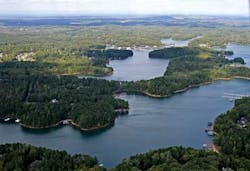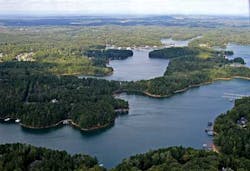Staying Competitive: Could Water Quality Trading be a Solution?
By Hannah Mellman
In the last decade, EPA regulations on wet weather-related discharges, biosolids management, and nutrients from municipal, industrial, and commercial sources have expanded to help address the severe levels of water degradation around the country. While water quality around the country has improved, the cost of wastewater treatment has increased enormously. Given the current economic environment, how can commercial and industrial entities make the necessary upgrades to protect public health and the environment without losing their competitive edge?
For over 40 years, the National Association of Clean Water Agencies (NACWA) has been at the crux of this challenge as it relates to publically owned wastewater treatment plants, pursuing national policies and approaches that seek to stretch ratepayer dollars as far as possible in order to ensure that the nation's waters are clean and safe and meet the strict requirements of the Clean Water Act.
Water quality trading is one such approach, and NACWA recently formed a Water Quality Trading Working Group to provide a utility perspective on whether trading can achieve more efficient water quality improvements. While the Association has weighed in on trading issues in the past, this is the first time NACWA has formed a group dedicated to the issue, signifying the growing recognition that this approach can provide a credible alternative to traditional regulatory approaches.
The Nutrient Challenge
Excessive amounts of nutrients, primarily nitrogen and phosphorus, in waterways now represents the single largest pollution problem facing our nation's waters. More than 60 percent of the rivers and bays in every coastal state are moderately to severely degraded by nutrient pollution, and nutrients are contributing to some of the largest algal blooms, fish kills, shellfish poisonings, and aquatic deadzones in the country.
Effluent discharges from point sources, like commercial and industrial entities, are a significant source of nutrient pollution in surface waters. As a result, EPA has increased its focus on controlling nutrient discharges from these sources. Yet point sources are neither the only nor the greatest source of nutrient pollution in many waterways. Runoff from agricultural land, rich in nutrients from fertilizer and livestock manure, is responsible for more nutrient pollution than any other source. Despite this, most agricultural producers are exempt from the water pollution control requirements of the CWA.
This leaves the brunt of the work to mitigate nutrient pollution to the point sources, which rely on expensive technology controls and upgrades to reduce their nutrient loadings. While these facilities strive for compliance, there are two problems with this model. First, nutrient removal technology is extremely expensive, and second, even if a facility is able to completely remove the nutrients from its discharge, it may not lead to sizable reductions in overall nutrient loads in waterways and improvements in water quality.
In the Midwest, nutrient pollution in the Mississippi River is responsible for a deadzone in the Gulf of Mexico that measures almost 3,000 square miles. Yet, point sources are only responsible for 12 percent of the phosphorus and 9 percent of the nitrogen delivered to the Gulf, compared to agricultural and range land, which is responsible for 80 percent and 71 percent respectively.
Clearly, there is a disconnect between current water quality management and implementation practices and what is needed to improve water quality. Instead, a more holistic approach to watershed management should be adopted to collectively engage and address all sources and activities contributing to nutrient pollution.
Water Quality Trading
Water quality trading continues to gain interest among industry and agricultural producers as a viable market-based alternative to control water pollution. This approach is based on the idea that pollution sources in a watershed face very different costs to control the same pollutant. So, permitted emitters with high abatement costs could purchase equivalent nutrient reductions from a cheaper source, like agriculture, to help meet their regulatory requirements.
There are three main benefits to water quality trading: First, water quality trading has the potential to meet nutrient load requirements at lower overall costs. The cost to remove a pound of nitrogen or phosphorus from farm runoff and drainage is typically 4 to 5—and sometimes up to 10 to 20—times less than the cost to remove the same amount from wastewater. Second, the economic incentive created for farmers who engage in nutrient management activities means that water quality trading can potentially generate environmental benefits beyond those that would be achieved under traditional regulation, like wildlife habitat and floodwater control. Finally, water quality trading helps move water quality control efforts towards a watershed-based approach, collectively addressing all sources and activities contributing to watershed degradation.
It is easy to see why an industrial entity, stretched beyond the brink of its financial capacity, would see water quality trading as appealing. This approach can address the lowest-hanging fruit in terms of nutrient reduction, saving companies money, engaging sectors that may not otherwise participate in nutrient reduction activities, and encouraging water quality improvements that go above and beyond minimum pollution control requirements.
EPA Trading Policy
According to EPA, there are currently 49 water quality trading programs active or under development in the U.S. Of those, less than half include trading between public wastewater utilities and agricultural and fewer still involve permitted private entities. If the environmental and economic benefits of adopting a market-based approach to meet nutrient requirements are overwhelmingly positive, why haven't these markets been more readily adopted?
Successful water quality trading programs depend on quite a few factors. These include the ability to establish and enforce a pollution cap, handle the complexity associated with establishing verifiable agricultural credits, and avoid the creation of hot spots, or localized areas with high levels of nutrients within a watershed. Equally important is the need for more consistent support and greater promotion of water quality trading from the federal government.
In 2003, EPA released its Water Quality Trading Policy to provide states and interstate agencies with guidance in developing and implementing water quality trading programs. This policy was the first time EPA has recognized water quality trading as a viable approach to reducing certain types of water pollution. Its release signified a broader shift in environmental policymaking from top-down strategies to one that fosters commodification and local ownership.
While it is certainly positive to see EPA endorse a market-based approach to nutrient management, NACWA has urged EPA to update the policy and clarify language the association fears could in fact limit trading and the broader establishment of regional water quality trading programs.
First and foremost, NACWA urges EPA to encourage water quality trading if trading can meet environmental goals equal to or greater than those under existing regulatory programs, not only where trading achieves greater environmental benefits as the policy states. Achieving ancillary environmental benefits is certainly encouraged but trading should not be disregarded if a program is capable of achieving environmental benefits equal to those under regulation at less cost.
Secondly, NACWA is concerned with how the policy defines the areas under which trading may occur.
According to EPA's policy, "All water quality trading should occur within a watershed or a defined area for which a Total Maximum Daily Load (TMDL) has been approved."
Under the CWA, a waterbody that fails to meet one or more of its designated uses is declared "impaired" and a TMDL is developed, which allots a maximum amount of a pollutant the waterbody can receive and still safely meet water quality standards. TMDLs can certainly help facilitate trading as they define a trading area and establish a pollution cap for each pollution source. Nevertheless, NACWA fears EPA's policy could be interpreted as only endorsing trading where a TMDL has been established.
Relying on a TMDL to establish a trading program is constraining and could hamper the development of new domestic markets. Around the country, many segments of streams and rivers, lakes, and coastal waterbodies are facing enormous nutrient problems despite not being declared impaired or having a TMDL. Furthermore, implementing a TMDL is a cumbersome and, at times, contentious process. It requires setting a controversial pollution limit to be recognized by pollution control mandates on some or all pollution sources. In cases where agriculture is involved, translating broad mandates to individual producers and ensuring long-term compliance is especially difficult.
It is critical EPA recognize that trading can be just as effective, if not more so, in the absence of a TMDL. The Electrical Power Research Institute's (EPRI) Ohio River Basin Trading Project is one example of a voluntary nitrogen and phosphorus trading program not linked to a TMDL. In August 2012, EPRI launched the pilot phase of the project, which covers parts of Ohio, Kentucky, and Indiana. It is the only active interstate trading program in the country and on its way to being one of the largest and most sophisticated water quality trading programs ever developed. To see the implementation of more programs like EPRI's, EPA should be receptive to water quality trading programs under a wide variety of circumstances.
Finally, NACWA is concerned that baseline requirements for agriculture may hinder trades in water quality trading programs. According to EPA, farmers must first comply with baseline, or pollutant control requirements, before they can be eligible to generate and sell credits. Baseline requirements take the form of best management practices (BMPs) that are consistent with the water quality goal.
Under the CWA, there are no requirements for agriculture to adopt BMPs even in the presence of a TMDL. By requiring a minimum practice standard to participate in a trading program, EPA is disqualifying the least costly reductions from being offered as offsets. Farmers who have not voluntarily adopted the minimum set of practices prior to the start of a trading program may not find it in their interest to enter the market because of the entry cost associated with meeting a baseline. NACWA fears this competitive disadvantage could ultimately limit participation, hampering credit supply and adversely affect market efficiency.
Although it is unlikely EPA will revise their Water Quality Trading Policy in the near future, NACWA plans to continue discussions with EPA and other stakeholders about ways to further the development of water quality trading policies and programs that will yield tangible water quality and environmental improvements while addressing the affordability concerns of industry around the country.
About the Author: Hannah Mellman is Manager of Legislative Affairs at the National Association of Clean Water Agencies. For more information on NACWA's water quality trading efforts, she may be contacted at [email protected].

